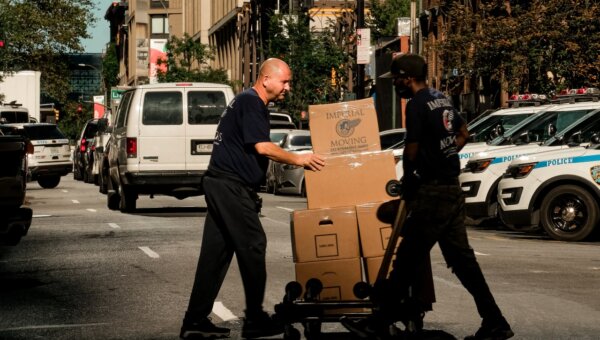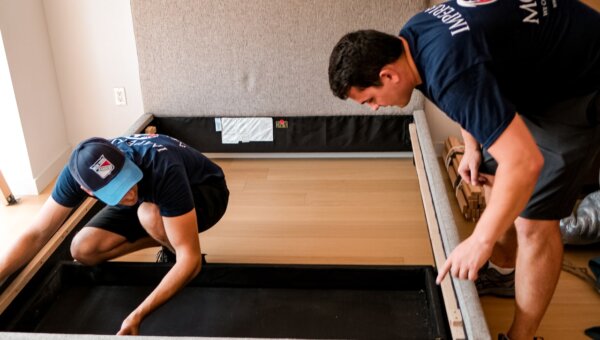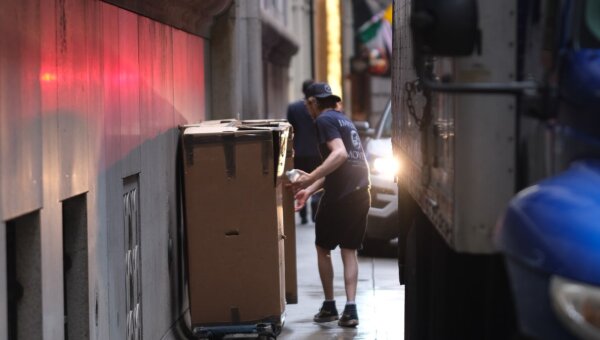Your kitchen may be one of the most challenging rooms in the home to move, but it’s also one of the most essential to your everyday living. While stacks of dishes and boxes of pots and pans might be easy enough to tackle on your own, you might want to consider hiring a professional mover to transport bulky items like the appliances. However, if you’d rather muscle-up and do-it-yourself, here are a few words of advice.
How to Move a Refrigerator
Follow these ten steps to transport a refrigerator safely:
- Clean out contents
- Unplug and let the freezer compartment defrost 6-8 hours
- Wipe down the inside to remove moisture
- Remove and pack glass shelving
- Disconnect water line and empty water reservoir
- Tape cord and small parts to the back of the fridge
- Secure door using a cable or rope
- Transport in an upright position using appliance dolly and ratchet strap
- Secure in the truck using tie-downs
- At destination, let sit for 2-3 hours before plugging in
Clean out the contents and unplug the refrigerator. It is best to let it sit 6-8 hours to defrost and allow moisture to evaporate thoroughly. This step will prevent mold and mildew from growing inside the fridge (particularly important for a long distance move or if you’re putting the unit in storage). Remove any glass shelves and pack separately. You may want to label the shelves for easier assembly when you put it back together. Disconnect the water line to the ice maker or water dispenser and empty the water reservoir. Again, make sure to dry all of these components thoroughly. Tape the power cord to the back of the refrigerator. You may want to place any small parts in small plastic bag and tape to the back as well. Secure the door with a durable cord or rope or tie the doors together. Make sure the refrigerator stays in an upright position. Never move a fridge on its side as doing so may cause irreparable damage to the compressor. Move the fridge using a hand truck or dolly; be sure to have 2-3 people assisting to ensure the fridge remains balanced and stable. In the truck, use tie downs to secure the refrigerator in place, so it doesn’t shift during transport. When you reach your destination, let the refrigerator sit for two or three hours before plugging it in to allow the fluids to flow back into the compressor.
How to Move an Oven
When moving a gas oven, you may want to enlist the help of a knowledgeable technician to disconnect the gas line properly. Here are some additional steps to follow:
- If a gas stove, turn off the gas line
- Remove bottom drawer & racks
- Tip the unit back and slide cardboard underneath the front legs
- Pull oven out, using the cardboard to prevent scratching the floor
- Disconnect power cord and gas line (make sure to turn this off first!)
- Tape door closed or remove from hinges
- Place on an appliance dolly and secure with a ratchet strap
- Secure in truck using tie-downs to keep it from moving during transit
If your stove is gas, turn the gas valve to the off position and unscrew the flexible tubing. Remember, just as with your dyer, disconnecting the gas is a task best left to a qualified technician. Pull the stove out enough so you can get behind it to unplug the power cord and gas line if it is a gas stove. You may want to use a piece of heavy cardboard or plywood to protect your floors when moving the oven. Tip the stove back to slide the cardboard under the front legs. Some stoves have an anti-tipping device that will need to be disengaged. Once the oven is pulled out from the wall, tape the door closed or remove it from the hinges, if possible. Remove knobs and racks and pack them separately. Place the oven on an appliance dolly, and remember never to lift your stove by the door handle. Make sure there’s at least one other person (if not more) on hand to assist you. Don’t try to move a heavy oven on your own!
With some planning and preparation, you can move your large kitchen appliances safely to your new home. However, do not hesitate to seek out a professional to assist. You may find hiring movers to be more reasonable than you thought and save yourself the risk of injury.












